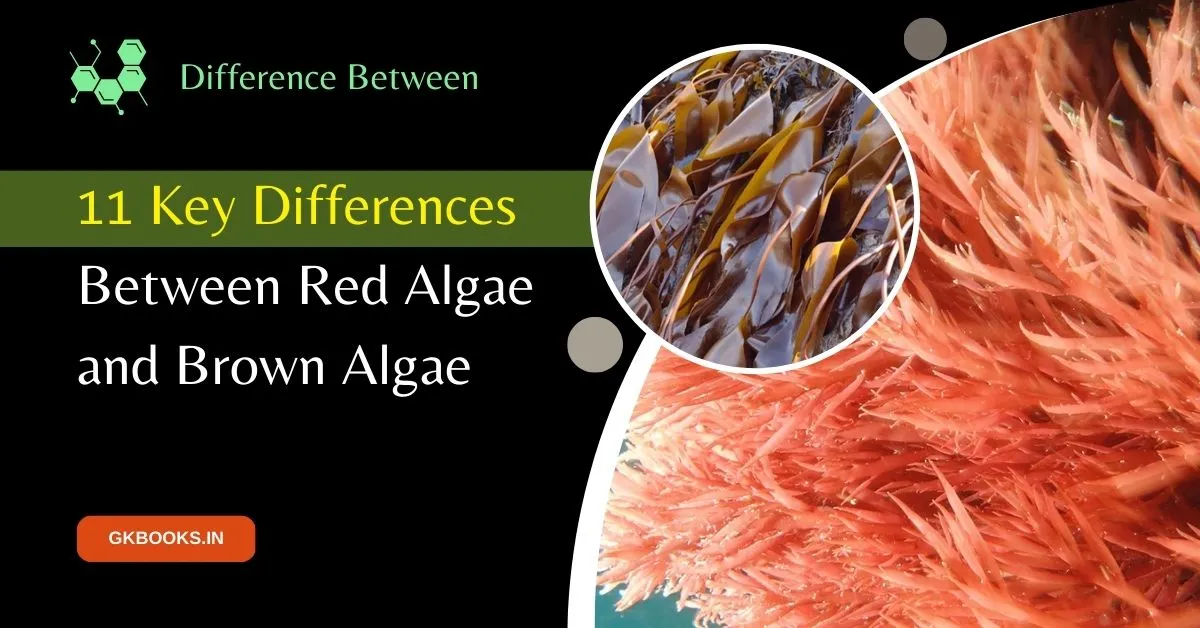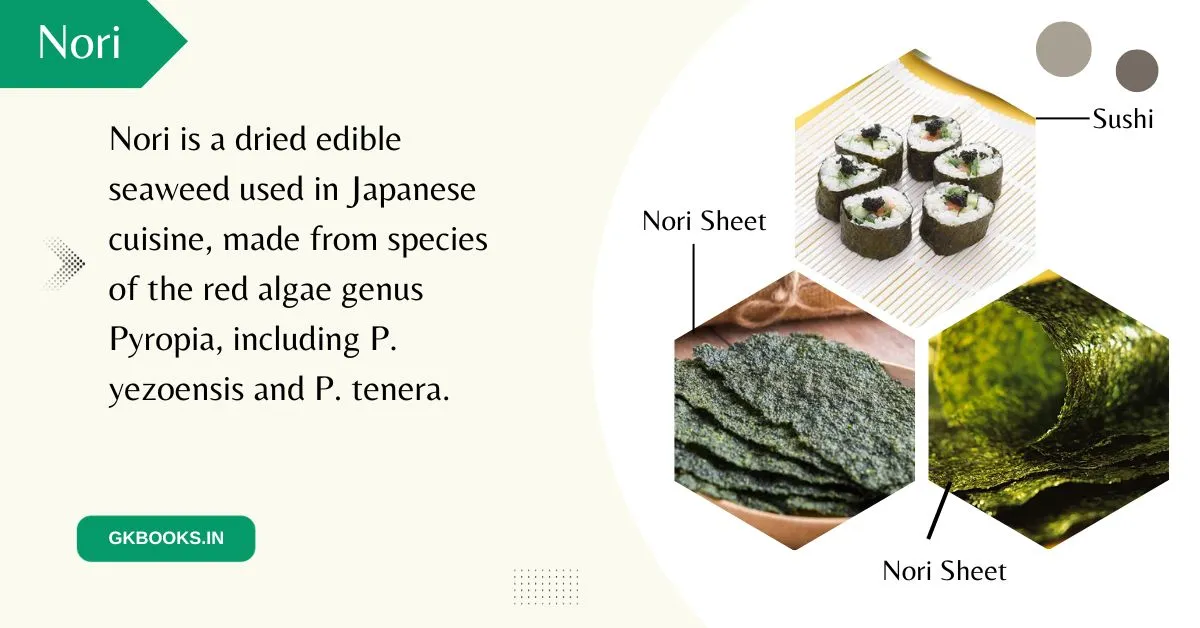Explore the 11 significant Differences between Red Algae and Brown Algae, accompanied by additional information about each. This information is invaluable for gaining a comprehensive understanding of both types of algae, and it can prove beneficial in answering specific questions about their differences in exams.

The Colorful World of Algae
Imagine a vast underwater forest, not made of trees, but of vibrant, waving plants. This is the world of algae, a diverse group of organisms that come in all shapes, sizes, and colors.
Today, we’re going to focus on two fascinating types of algae: red algae and brown algae. While they’re both algae, they have some surprising differences!
Red Algae: The Blush of the Sea
- Red algae get their name from their stunning red color, which comes from a special pigment called phycoerythrin.
- This pigment helps them capture sunlight for photosynthesis, even in deeper waters where other colors don’t reach.
- Red algae often have delicate, feathery shapes and can be found in tropical and temperate waters around the world.
- Some types of red algae are even used to make agar, a jelly-like substance used in food and cosmetics.
Brown Algae: The Giants of the Kelp Forest
- Brown algae are the giants of the underwater world. Some kelp species can grow hundreds of feet tall!
- They are typically brown or greenish, thanks to a pigment called fucoxanthin. This pigment helps them capture sunlight in shallow waters.
- Brown algae are found in cold, nutrient-rich waters and form the foundation of kelp forests, which provide food and shelter for many marine animals.
So, what are the key differences between red and brown algae?
- Color: Red algae are red, while brown algae are brown or greenish.
- Pigments: Red algae have phycoerythrin, while brown algae have fucoxanthin.
- Habitat: Red algae can live in deeper waters, while brown algae prefer shallow, nutrient-rich waters.
- Size: Brown algae tend to be much larger than red algae.
Beyond these basic differences, red and brown algae also have unique features and characteristics that make them special. For example, some red algae can reproduce without needing a partner, while some brown algae have complex life cycles that involve multiple stages.
I hope this gives you a glimpse into the amazing world of red and brown algae! By learning about their differences and adaptations, we can gain a deeper appreciation for the incredible diversity of life in our oceans.
Remember:
- There are many other types of algae besides red and brown, each with its own unique characteristics.
- Algae play an important role in the health of our oceans and the planet.
- We can all help protect algae and other marine life by reducing pollution and making sustainable choices.
Let’s dive deeper into the fascinating world of red and brown algae. We’ll first explore their unique characteristics and then take a closer look at 11 key differences in a handy table.
Unveiling the Secrets of Red Algae: Nature’s Ruby Red Wonders
Red algae, with their vibrant crimson hues, are not just beautiful underwater plants – they’re also ancient powerhouses boasting a fascinating history and unique characteristics. Let’s dive into the world of these ruby-red wonders!
A Lineage Steeped in Time
- Imagine a world before dinosaurs, when the first complex life forms were taking root in the oceans. That’s when red algae, belonging to the division Rhodophyta, first emerged.
- Their name, derived from the Greek words “rhodon” (rose) and “phyton” (plant), hints at their delicate beauty and ancient lineage.
A Multitude of Forms
- With over 7,000 identified species, red algae are one of the largest groups of algae.
- Most belong to the class Florideophyceae, thriving in marine environments with their multicellular bodies.
- Picture vast underwater forests of these stunning crimson beauties swaying gracefully beneath the waves!
Unveiling the Mystery of Their Color
- Unlike their green counterparts, red algae get their stunning color from a special trick. Their chlorophyll, the pigment responsible for photosynthesis, is masked by other pigments called phycobilins.
- These include phycocyanin (blue) and phycoerythrin (red). The latter, like a ruby filter, reflects red light and absorbs blue light, painting the algae in shades of crimson.
A Treasure Trove of Nutrients
- Red algae aren’t just eye-catching – they’re also a valuable source of food. In Asia, especially, their high content of vitamins, minerals, and other nutrients makes them a popular culinary choice.
- Dishes like nori, used in sushi, are just one example of how these algae enrich our tables.

Red Algae’s Impact on the World
- Red algae don’t just grace our plates and beautify the oceans – they play a crucial role in the environment. They provide food and shelter for countless marine creatures, and some even help build coral reefs, vital ecosystems teeming with life.
Exploring the Wonders of Red Algae
With their ancient lineage, dazzling colors, and vital contributions to the planet, red algae are truly wonders of nature. So, the next time you see a seafood dish featuring these ruby red gems, remember the fascinating story they hold beneath their vibrant surface.
Brown Algae: Kings of the Kelp Forest
Imagine a vast underwater forest, not of trees, but of swaying giants in shades of brown and green. This is the world of brown algae, a diverse group of over 1,500 species that dominate the colder waters of the Northern Hemisphere. But they’re not just seaweed giants! Here’s a peek into their fascinating world:
Multicellular Marvels
- Unlike some other algae, brown algae are always multicellular. They’re not lone adventurers or cell colonies, but complex beings with specialized structures. Think of them as miniature underwater trees, with roots, stems, and even leaf-like blades!
Fucoxanthin’s Fantastic Filter
- The secret behind their striking color lies in a special pigment called fucoxanthin. Like a magic lens, it captures sunlight and lets the green of chlorophyll peek through, resulting in those unique shades of brown and green.
Food Web Champions
- Brown algae are the kings of the kelp forest food chain. They provide a feast for hungry herbivores, who in turn nourish larger predators. In this way, they maintain the delicate balance of the marine ecosystem.
Beyond Food
- These underwater giants aren’t just lunch! They offer crucial shelter and breeding grounds for a variety of marine creatures, from tiny invertebrates to majestic fish. Their intricate forests provide safe havens and nurseries for countless species.
More Than Just Kelp
- While kelp forests are famous for brown algae, there’s a whole world of diversity! From delicate filamentous algae clinging to rocks to bladderwrack bobbing with the tides, each species plays a unique role in the ocean’s tapestry.
11 Key Differences Between Red Algae and Brown Algae
Both Red Algae and the Brown Algae groups fall under the plant kingdom and are classified as Algae species. However, they exhibit numerous distinctions in their overall morphology and features, including variations in appearance and the types of pigments present. The following table provides some key variations between Red Algae and Brown Algae, emphasizing their distinct characteristics and features.
| SL. No. | Characteristics or Features | Brown Algae | Red Algae |
|---|---|---|---|
| 1 | Flagella | Brown Algae have two unequal and lateral flagella | Red Algae doesn’t contain flagella. |
| 2 | Photosynthetic Pigments | Brown algae possess photosynthetic pigments such as chlorophylls a and c, along with the presence of the fucoxanthin pigment, which contributes to their green-brownish color. | Red Algae contain chlorophylls a and c as their main photosynthetic pigments, and they also have phycoerythrin as their third pigment, giving them their reddish color. |
| 3 | Stored Food | Brown Algae store food in the form of laminarin or mannitol. | Red Algae store food in the form of floridean starch. |
| 4 | Cell Wall | The cell walls of Brown algae species are mainly composed of algin and cellulose. | The cell wall of the red algae group consists of phycocolloids, pectin, and cellulose. |
| 5 | Grouping | Species belonging to the brown algae group fall under the class Phaeophyceae. | On the other hand, species belonging to the red algae group are classified under the class Rhodophyceae. |
| 6 | Ecological Importance | Brown algae play a crucial role as a primary source of food, making them essential for sustaining food cycles and webs in marine environments. | Red algae serve as a vital food source for marine species and are also consumed by humans due to their high nutrient value. |
| 7 | Habitat | Brown Algae is commonly found in colder marine environments, including rocky shores and deeper waters. | Red Algae thrive in warmer marine environments and are often found in tropical and subtropical regions. |
| 8 | Size | Brown Algae species are typically larger and more structurally complex, with some growing into large seaweeds. | Red Algae species vary in size, and while some are microscopic, others can form sizable structures like coralline algae. |
| 9 | Reproduction | Brown Algae reproduce through a combination of asexual and sexual reproduction, involving spore production and gamete fusion. | Red Algae also reproduce both sexually and asexually, utilizing various methods such as spore release and alternation of generations. |
| 10 | Economic Importance | Brown Algae has economic significance as a source of alginates, which are used in food, pharmaceuticals, and industry. | Red Algae contribute economically through the extraction of agar, carrageenan, and other compounds used in food, cosmetics, and medical applications. |
| 11 | Depth Range | Brown Algae can grow at various depths, from shallow waters to deeper ocean regions. | Red Algae are often adapted to live at greater depths in the ocean due to their ability to absorb blue light. |
The above-mentioned differences highlight the key differences between red algae and brown algae. However, these two groups of species can exhibit many other variations.
You May Like:
All About Algae: Types, Classification, Examples and Economic Importance

